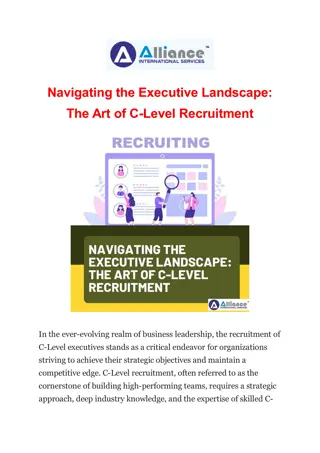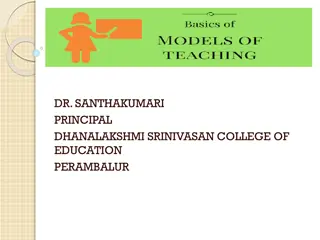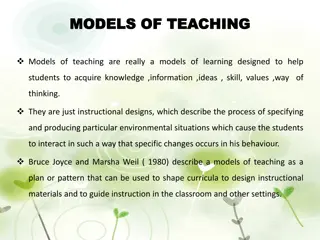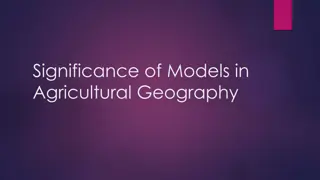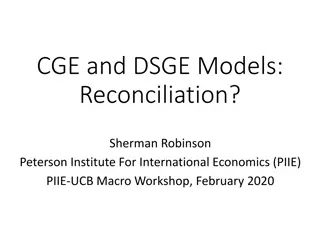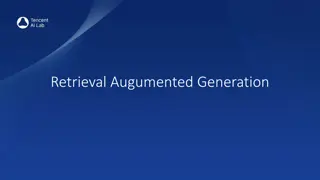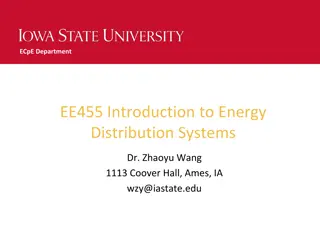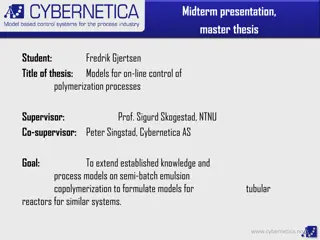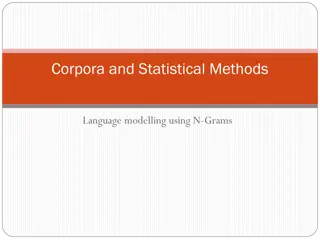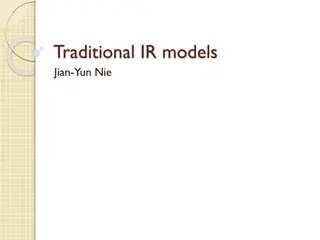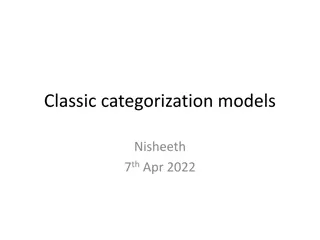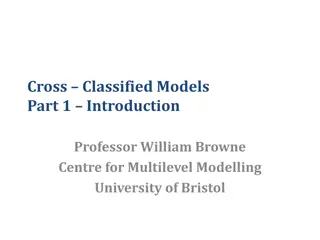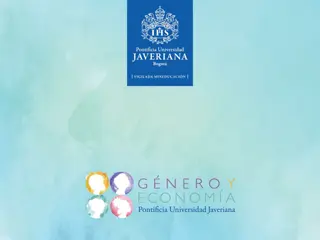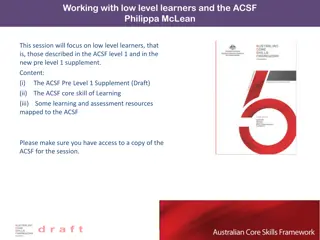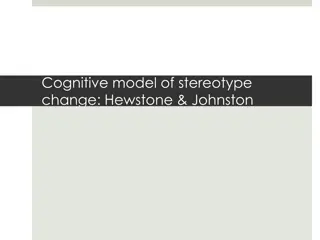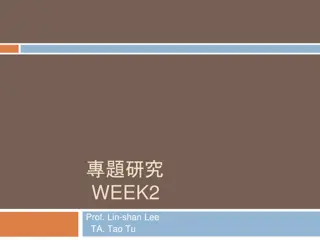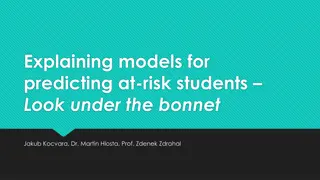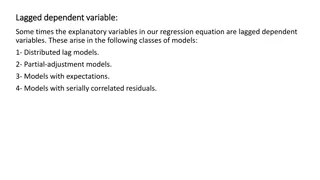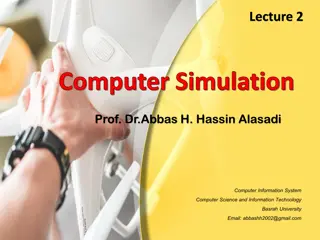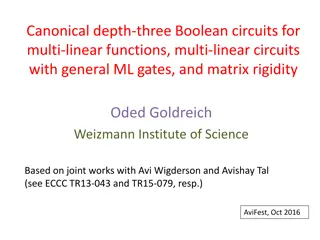Global Climate Models
Scientists simulate the climate system and project future scenarios by observing, measuring, and applying knowledge to computer models. These models represent Earth's surface and atmosphere using mathematical equations, which are converted to computer code. Supercomputers solve these equations to pr
3 views • 15 slides
System Models in Software Engineering: A Comprehensive Overview
System models play a crucial role in software engineering, aiding in understanding system functionality and communicating with customers. They include context models, behavioural models, data models, object models, and more, each offering unique perspectives on the system. Different types of system
6 views • 33 slides
Input-Output Models in Economics
Input-Output models, pioneered by Wassily Leontief, depict inter-industry relationships within an economy. These models analyze the dependencies between different sectors and have been utilized for studying agricultural production distribution, economic development planning, and impact analysis of i
9 views • 7 slides
Introduction to Three-Level Meta-Analysis Models in R: A Practical Example
Explore three-level meta-analysis models in R with a focus on the association between paternal anxiety and child emotional problems. Learn to prepare data files, fit models using the rma.mv function in metafor, and understand the structure of the formula for random effects. Follow along with a step-
9 views • 22 slides
Navigating the Executive Landscape: The Art of C-Level Recruitment
\"Navigating the Executive Landscape: The Art of C-Level Recruitment\" is a comprehensive guide for C-level recruiters, providing invaluable insights and strategies for navigating the complexities of c level recruitment. Delve into the intricacies of executive search with expert guidance tailored to
2 views • 6 slides
Models of Teaching in Education
Exploring different models of teaching, such as Carroll's model, Proctor's model, and others, that guide educational activities and environments. These models specify learning outcomes, environmental conditions, performance criteria, and more to shape effective teaching practices. Functions of teach
4 views • 20 slides
Models of Teaching for Effective Learning
Models of teaching serve as instructional designs to facilitate students in acquiring knowledge, skills, and values by creating specific learning environments. Bruce Joyce and Marsha Weil classified teaching models into four families: Information Processing Models, Personal Models, Social Interactio
1 views • 28 slides
Three-Way Interactions in Regression Models
Three-way interactions in regression models add complexity to interpreting the effects of predictors. This article explains how to decompose three-way interactions in Stata, model them effectively, and assess their significance using contrast tests. Practical examples and Stata commands are provided
2 views • 17 slides
Significance of Models in Agricultural Geography
Models play a crucial role in various disciplines, including agricultural geography, by offering a simplified and hypothetical representation of complex phenomena. When used correctly, models help in understanding reality and empirical investigations, but misuse can lead to dangerous outcomes. Longm
1 views • 8 slides
CGE and DSGE Models: A Comparative Analysis
Explore the similarities between Computable General Equilibrium (CGE) models and Dynamic Stochastic General Equilibrium (DSGE) models, their equilibrium concepts, and the use of descriptive equilibria in empirical modeling. Learn how CGE and DSGE models simulate the operation of commodity and factor
4 views • 15 slides
Enhancing Information Retrieval with Augmented Generation Models
Augmented generation models, such as REALM and RAG, integrate retrieval and generation tasks to improve information retrieval processes. These models leverage background knowledge and language models to enhance recall and candidate generation. REALM focuses on concatenation and retrieval operations,
2 views • 9 slides
Item Response Theory in Measurement Models
Item Response Theory (IRT) is a statistical measurement model used to describe the relationship between responses on a given item and the underlying trait being measured. It allows for indirectly measuring unobservable variables using indicators and provides advantages such as independent ability es
3 views • 32 slides
Discrete Optimization in Mathematical Modeling
Discrete Optimization is a field of applied mathematics that uses techniques from combinatorics, graph theory, linear programming, and algorithms to solve optimization problems over discrete structures. This involves creating mathematical models, defining objective functions, decision variables, and
2 views • 12 slides
Energy Distribution System Line Models
This presentation delves into the various line models used in energy distribution systems, including exact line segment models and their derivation from Kirchhoff's voltage and current laws. The discussion covers three line segment models, the computation of phase impedance and admittance matrices,
0 views • 44 slides
Observational Constraints on Viable f(R) Gravity Models Analysis
Investigating f(R) gravity models by extending the Einstein-Hilbert action with an arbitrary function f(R). Conditions for viable models include positive gravitational constants, stable cosmological perturbations, asymptotic behavior towards the ΛCDM model, stability of late-time de Sitter point, a
1 views • 12 slides
Wireless Propagation Models: Challenges and Applications
Wireless propagation models play a crucial role in characterizing the wireless channel and understanding how signals are affected by environmental conditions. This article explores the different propagation mechanisms like reflection, diffraction, and scattering, along with the challenges and applic
1 views • 14 slides
Models for On-line Control of Polymerization Processes: A Thesis Presentation
This presentation delves into developing models for on-line control of polymerization processes, focusing on reactors for similar systems. The work aims to extend existing knowledge on semi-batch emulsion copolymerization models, with a goal of formulating models for tubular reactors. Strategies, ba
0 views • 16 slides
N-Gram Models in Language Modelling
N-gram models play a crucial role in language modelling by predicting the next word in a sequence based on the probability of previous words. This technology is used in various applications such as word prediction, speech recognition, and spelling correction. By analyzing history and probabilities,
0 views • 101 slides
Information Retrieval Models and Processes
Delve into the world of information retrieval models with a focus on traditional approaches, main processes like indexing and retrieval, cases of one-term and multi-term queries, and the evolution of IR models from boolean to probabilistic and vector space models. Explore the concept of IR models, r
1 views • 65 slides
Organization of Concepts in Categorization Models
Understanding the functions and structures of categorization models in cognitive processes. From hierarchical structures to preferred levels of conceptualization, learn about the basic level, superordinate level, and subordinate level of categorization. Discover the significance of the basic level i
0 views • 33 slides
Cross-Classified Models in Multilevel Modelling
Cross-classified models in multilevel modelling involve non-hierarchical data structures where entities are classified within multiple categories. These models extend traditional nested multilevel models by accounting for complex relationships among data levels. Professor William Browne from the Uni
2 views • 13 slides
General Equilibrium Models and Social Accounting Matrices
General Equilibrium Models (CGE) and Social Accounting Matrices (SAM) provide a comprehensive framework for analyzing economies and policies. This analysis delves into how CGE models help simulate various economic scenarios and their link to SAM, which serves as a key data input for the models. The
0 views • 50 slides
Supporting Low-Level Learners with ACSF: A Focus on Pre-Level 1 Skills
This session delves into assisting low-level learners based on the ACSF level 1 and pre-level 1 supplement. It covers the ACSF Pre-Level 1 Supplement, core learning skills, and resources aligned with the ACSF. Learners at this level show readiness for learning but may need varying levels of support
1 views • 20 slides
Retrieval Models in Information Retrieval
Retrieval models play a crucial role in defining the search process, with various assumptions and ranking algorithms. Relevance, a complex concept, is central to these models, though subject to disagreement. An overview of different retrieval models like Boolean, Vector Space, and Probabilistic Mode
0 views • 56 slides
Scientific Models and Their Applications
Explore the world of scientific models through this informative content covering physical, mathematical, and conceptual models. Discover why models are used in science, their types, and potential limitations. Delve into the importance of utilizing models to comprehend complex concepts effectively.
0 views • 21 slides
Composite Models in Building Complex Systems
Composite models are essential in representing complex entities by combining different types of models, such as resource allocation, transport, and assembly models. Gluing these models together allows for a comprehensive representation of systems like the milk industry, where raw materials are trans
0 views • 27 slides
Cognitive Model of Stereotype Change: Three Models Explored
The Cognitive Model of Stereotype Change, as researched by Hewstone & Johnston, delves into three key models for altering stereotypical beliefs: the bookkeeping model, the conversion model, and the subtyping model. These models suggest strategies such as adding or removing features to shift stereoty
0 views • 58 slides
Current Policy Issues Regarding Three-Character Country Codes as Top-Level Domains
The GAC Agenda Item 10 discusses the possibility of using three-character country codes as top-level domains in the future rounds, addressing concerns of potential confusion with existing ccTLDs. The joint ccNSO and GNSO working group is exploring lifting restrictions on three-letter codes, with the
0 views • 6 slides
Three-Phase Relative Permeabilities in Reservoir Engineering
Explore the application, correlations, and traditional assumptions of three-phase relative permeabilities in reservoir engineering. Learn about saturation-dependencies, occupancy models, and the challenges of measuring three-phase relative permeabilities. Discover how to calculate three-phase permea
2 views • 14 slides
Speech Recognition and Acoustic Modeling
This presentation delves into the world of speech recognition, covering topics such as Hidden Markov Models, feature extraction, acoustic modeling, and more. Explore the essential elements of processing speech signals, linguistic decoding, constructing language models, and training acoustic models.
0 views • 34 slides
Explaining Models for Predicting At-Risk Students
Models for predicting at-risk students involve creating a predictive model to identify students at risk of failing a module early on. These models utilize machine learning algorithms, training data, and various factors to predict outcomes. Interpretable models focus on easily understandable criteria
0 views • 16 slides
Lagged Dependent Variable Models in Regression Analysis
Lagged dependent variables are utilized in various regression models such as distributed lag models, partial-adjustment models, models with expectations, and models with serially correlated residuals. By incorporating lagged dependent variables, researchers can analyze the impact of past values on t
0 views • 11 slides
Computer Simulation Models Classification
Computer simulation models are classified based on various characteristics such as static or dynamic, deterministic or stochastic, and discrete or continuous. Static models represent systems at a specific point in time, while dynamic models depict changes over time. Deterministic models involve no r
0 views • 8 slides
Lecture 8 Valuation Models for Stock Prices
Valuation models for stock prices, including Dividend Discount Models and Accrual Discount Models, are explored in this lecture. Learn about the history of Discounted Cash Flow models and their limitations in stock valuation using accounting data.
0 views • 53 slides
Colony-Level Simulation Models in Environmental Protection
This content discusses the use of colony-level simulation models by the U.S. Environmental Protection Agency for assessing risks related to honey bees. The models help understand biological processes, interpret sublethal endpoints, inform study designs, and integrate multiple stressors. However, exi
0 views • 8 slides
Colony-Level Simulation Models for Risk Assessment
This content discusses the use of colony-level simulation models by the U.S. Environmental Protection Agency for assessing risks related to honey bee populations. It explores the importance of understanding biological processes, interpreting measurement endpoints, and incorporating multiple stressor
0 views • 11 slides
Exploring Business Models in Innovation Centers
Delve into the world of business models within innovation centers like the Wyche Innovation Centre, understanding how different models transform ideas into valuable products/services. Learn about classification, benefits of categorizing businesses based on models, and the sustainability of adopting
0 views • 12 slides
Canonical Depth-Three Boolean Circuits for Multi-Linear Functions and Matrix Rigidity
Explore the study of canonical depth-three Boolean circuits for multi-linear functions, multi-linear circuits, and matrix rigidity with a focus on stronger circuit models and lower bounds. Consider multi-linear functions and depth-three circuits to improve circuit complexity. Discover explicit t-lin
0 views • 25 slides
Control Loop Models for Level Control in Automatic Process Control
Explore different types of level control specifications, including tight and averaging control, along with models for level control loops such as process model, control valve model, and sensor/transmitter model. Understand the dynamics of liquid level control systems and the applications in various
1 views • 11 slides
Understanding Equity Risk and Expected Return Models
Learn about equity risk and the different types of risks associated with investments, such as firm-specific risk and market risk. Explore expected return models like CAPM and APM, as well as multifactor models that aim to identify market factors driving risk. Find out how models like the Fama-French
0 views • 13 slides




